Source: CCTV.com
08-15-2006 13:33
 | |
Is this on? Hi, I’m Yin and welcome to Travelogue’s Street Special. We’re here in Beihai, one of China’s first trading ports. You’re probably wondering why I’m filming this myself, but there’s a perfectly good explanation. I promise to tell you later. Anyway, Behai is known for its brilliant pearls, beautiful beaches, and radiant sunshine. But you don’t have to take my word for it, let’s take a look around. Good, cut.
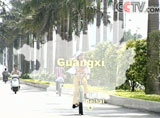 | |
Beihai literally means, “north of the sea”-- north of the Beibu Gulf or Gulf of Tonkin. The ocean town is perched on the southern tip of Guangxi Zhuang Autonomous Region and its strategic location explains why it served as a key center of trade as early as 2000 years ago.
Ah, tropical breezes, palm-lined boulevards, and plenty of water. That’s Beihai for you in a nutshell. Previously regarded only as a stop along the way to Hainan or Vietnam, Beihai is slowly drawing a growing crowd of maritime enthusiasts.
In this street special, we will explore three types of streets: the old streets of Beihai, the coastline, and the “street of ships” lining the water.
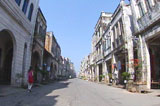 | |
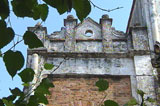 | |
The two oldest streets are Zhongshan Road and Zhuhai Road, built around 1883. These two roads run parallel on the northern coastline and are lined with a special building called the qilou.
The qilou is a special structure in Beihai. It literally means “building riding on top”, because it seems to ride above the passageway, on these thick pillars. Although not unique to Beihai, it is especially well preserved here
Because of Beihai’s openness as a trading port and exposure to foreign influence, many Western structures were built around the late 19th century. The qilou is one of them. These ancient colonial buildings are a harmonious mixture of western and Chinese style, adding to the sleepy tropical atmosphere. Aside from their unique beauty, you can also appreciate them for their functional value on a hot summer’s day.
See, the qilou is perfect. Here, you don’t have to worry about the burning sun. Also, you can get some great sights since the residents who live here post bright red banners outside their houses to wish you fortune and good luck.
 | |
The banners on the doors bring in fortune, while the posters of guards drive away evil spirits. Scary, huh?
One quick glance at this street and you may suppose you are in Europe. But don’t assume that what you see is an exact replica of Western architecture. A closer look and you will discover deep-rooted Chinese culture embedded in everything. The pathways and the narrow alleyways between the buildings on the street are indeed distinctive.
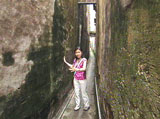 | |
Can you guess how many households live on the other side of the wall? Actually, just one, even though it’s so long and deep. Most houses are next to each other, so there’s no lanes at all. But this one is unique. There’s not even any windows. Can you imagine how dark it is?
Under the qilou, you can witness the essence of local Beihai life. The pathways are considered an extension of the streets where residents sit and relax, and shopkeepers get ready for business. Zhuhai road was formerly the center for activity, but the street is not inhabited by many residents today.
But those you do meet sure are friendly.
Although the commercial center has moved elsewhere, you can see remnants of their past. Along the street are shops for household goods, fishing shops, and clothing items.
My time is limited, and Zhuhai Road is over 1 km long, so I’d better speed things up.
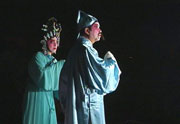 | |
A long day of exploration goes well with a relaxing evening. In the center of the city, you can find opera every night from 8 to 10:30, so long as it doesn’t rain. The local Yue opera is a free performance that draws large crowds. I have to admit that I didn’t understand a word they sang in the local dialect. However, that didn’t keep me from enjoying the songs just the same. Hey, wake up… you’re missing a good show! Although the stage is simply set in the street, the performance is quite formal and the singers take their roles very seriously, applying stage makeup. By the way, most of the singers are over 50 years old.
But just because they’re not young pop stars mean they don’t have loyal fans. This woman is the local Britney Spears. In fact, many people buy bunches of flowers to give to her. I spent two RMB and look at the huge bouquet I got. What I didn’t know was that there’s a system of flower recycling. Just after you give the flowers, a person will bring them back and resell them. Hey, those are mine!
 | |
What is there to do in Beihai? One of the main tourist attractions is the Exhibition Center for Shellfish and Coral. The museum boasts a collection of live shellfish and coral, collecting varieties all over world. Many are much bigger than those you can find on the beach.
She sells seashells by the seashore. She sells seashells by the seashore. She sells seashells by the seashore. But these are so nice, why would she want to sell them.
The museum has over 600 varieties of shellfish, including 7,000 pieces. One is worth over $80,000. Let’s try to find it.
Indeed, nice. But definitely pricey.
That’s not it… maybe this? Could this be it?
Host: I heard there’s one worth $80,000.
Museum: Yes, from appearance it’s not very beautiful, but it is very rare. Perhaps it’s an extinct species now.
Besides shellfish, the museum boasts an impressive collection of coral. Coral can live up to 1,200 years, but usually die prematurely due to environmental destruction
It’s rare to find so many different types of coral in one place, since they exist in many parts of the world. You might also have to swim to the depths of the ocean. This one looks like it’s waving its hand to say hello.
 | |
The colors of the coral are often so striking that you might think the lighting is playing tricks on your eyes. However, what you see is the natural color of the coral. The colorless lighting’s main function is to allow coral photosynthesis.
This here is not coral, but a sea flower. It has a special relationship with the clownfish. They are mutually interdependent. The clownfish hides in the sea flower, since the sea flower is poisonous to many of the clownfish’s predators, while the clownfish often finds food the sea flower. So, they’re very good friends.
It is also called a sea anemone. Although it looks like a flower, it actually is a meat-eating animal that uses its poisonous tentacles to sting its prey and then pushes it into its mouth.
Beihai is well known for its bright and shiny pearls. But do you know how they are made? The pearls are made by the using this tool to open the shell, cutting a slit, and inserting a foreign particle into the shell. Over time, the shell will make secretions around the particle and in three years, a pearl will be formed.
China tops the world in the annual output of pearls, which now surpasses 1,200 tons each year. The pearls here are called "South Pearls," the king of them all.
In the museum, you can see a display of oysters that have been deliberately induced to produce pearls by introducing an irritant. In nature, it’s very rare to see pearls, but behold the power of modern technology.
On the second floor of the museum is the largest pearl processing export base in Guangxi. Selection based on 4 characteristics: the pearl’s size, brightness, color, and flawlessness. After selecting the best pearls, they make necklaces and accessories.
Underwater World is another great place to take a look at the world beneath the ocean.
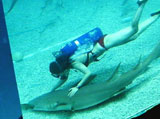 | |
It is a tourist attraction known for its many performances, including girls diving in six-meter water tank. You can also catch a glimpse of these girls doing some crazy things—yes, even feeding sharks. There they also play with FeiFei, a 300 year old turtle which is the biggest sea turtle in China. The show is around 20 minutes and is performed several times daily. That’s all folks. Bye!
In the museum, there’s a well-known glass tunnel, where you can feel submerged in the underwater world, surrounded by fish, rays, and sharks. Big, small, pretty, and you can decide for yourself
But fish are no fun to play with, so I found my friend Qiqi instead. Qiqi is a celebrity… who might give you a kiss. Yes, yes, the aim wasn’t too good on that one. I was kissed… again… and again… and again!
Hey, I want to kiss the host, too! Mom, I’m on television. How come he gets all the attention? Oh geez, let’s watch something else.
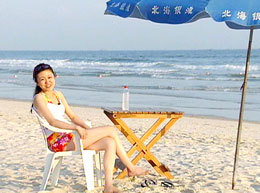 | |
Welcome to Silver Beach, Beihai’s number one tourist location. It’s properly named so for the fine, white sand. It’s a million dollar view.
Silver Beach lies to the south of Beihai, stretching 24 kilometres west and varies in width from 30 to 300 meters. The beach has a reputation as one of the best in China.
The best part is that admission is free! Here you can swim, play volleyball, and sunbathe.
Currently, Beihai is one of the 14 major open cities along the coast and the only city in the national minority autonomous regions that has direct access to the sea.
The ports are lined with freight vessels and row boats that aren’t just means of transportation, but also serve as homes. To move from one ship to another, you can take a 1 RMB water taxi.
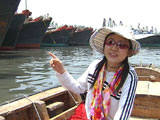 | |
The daily lives of these people, although seem slow, is actually quite busy. Beihai was formerly a fishing village, and many local people still make a living out of going out to sea to catch fish. Some even do business selling food and snacks by the water on their boats. These people are commonly known as “egg people” since their boats look like half an eggshell drifting on the water.
The fishermen constantly prepare to go out to sea. These trips can last anywhere from 6, 7 days to half a month. The man here is repairing his net after a catch, a common chore around the house. Speaking of his house, let’s see if he can give us a tour.
Host: What is this?
Fisherman: It’s an icebox.
This is a cooler for storing fish when it gets too hot. It’s similar to a refrigerator.
Take off your shoes. Let’s take a look at the bedroom. Windows here allow some light in. The room is small, but cozy.
From the outside, boats seem to be pretty plain and even old-fashioned, like they were transported in time from decades ago, but inside you will find that these ships are indeed very modern.
Captain, where are we? Actually, I can tell you exactly where we are because this is not your typical mom and pop rowboat. It’s equipped with the finest technology. This radar here will show our location and this screen displays where the fish are. It’s well equipped, so that the ship can do it’s own work while you take a rest.
I can’t imagine living on a boat, but these fishermen see their boats just like their houses, even decorating their boats just as we do our homes. These red flowers serve the same function as the red banners on the doors of the houses, bringing fortune and prosperity.
We need to go several hours to find the best spot for catching fish, so the trip can be quite long. But, I shall not rest to get the true experience of a fisherman!
 | |
Hope you’re not seasick, because this ship is real bumpy. And today will be my first time to go fishing. Never done it before, so hopefully we’ll get a good catch.
We are now further and further from Beihai back there. Today’s wind is especially strong, so you can see our ship is moving back and forth. Don’t know if my stomach can handle it much longer.
To be honest, I’m getting a little dizzy. Why is the captain so calm? Isn’t he shaky at all? Don’t look at me.
10, 9, 8, 7. I’m not seasick, I’m not seasick. I’m really not seasick.
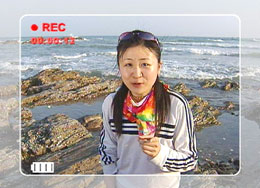 | |
So now you know why I’m here by myself… everyone is seasick! I thought fishing would be great. I’d go out to sea, catch big fish, have a grand supper. But no… luckily, I have this. So now I can fish on my own.
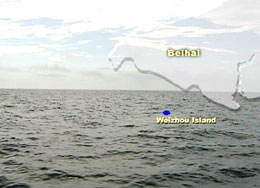 | |
A trip to Beihai is not complete unless you tour Weizhou Island, the youngest and largest volcanic island in China. The island is located 36 sea miles directly south of Beihai. The journey to Weizhou Island takes two and a half hours by small ferry. A view from above and you will see the result of volcanic activity and weathering.
We’re almost there.
The island is known as a "Museum of Volcanoes". I’m no geologist, so I’m largely unfamiliar with the formation and development of the Island. Seems like a mystery. So my first stop was the Museum of Weizhou Island
It’s unimaginable that Weizhou Island, like Hawaii, was formed as a result of tectonic activity and volcanic action. However, one big difference is that although the volcanoes of Hawaii are still active today, the ones in Weizhou Island saw their last eruption about 7,000 to 10,000 years ago. The exhibit in the museum includes remnants of the islands formation…including coral rocks and solidified lava.
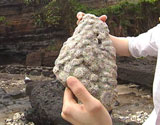 | |
This is a bomb, but don’t worry about it exploding because it’s a volcanic bomb, formed from solidified lava. When a volcano erupts, it fires lava into the sky. As the lava falls back to earth, it spins around quickly, cools and solidifies, forming a round shape.
 | |
On the island, you can find craters, and marine abrasion platforms. A good place to take a look at these is the Volcano National Park.
Editor:Chen Minji




